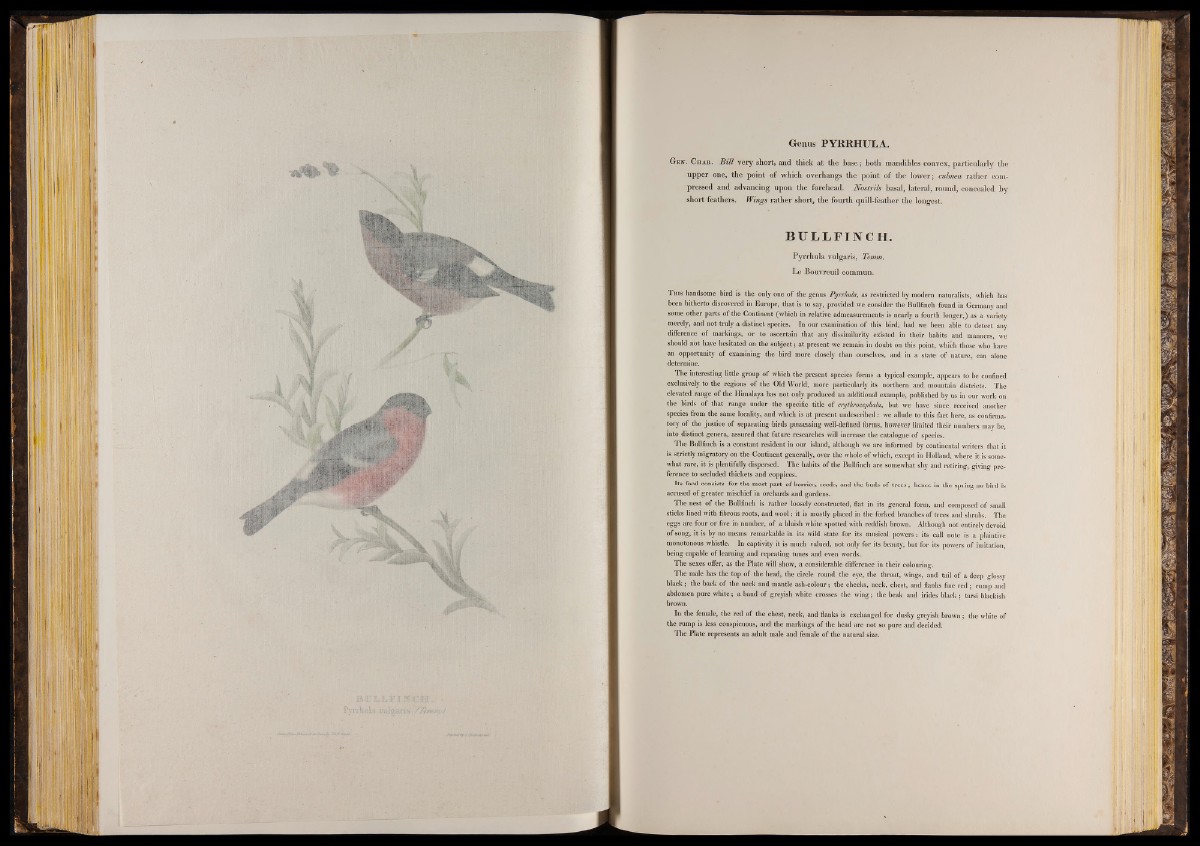
r ^ n r f 7
m u
j m
I M
Genus PYRRHULA.
Gen. C h a r . .5*7/ very short, and thick a t the base; both mandibles convex, particularly the
u p p e r one, the point of which overhangs the point of the lower; culmen rather compressed
and advancing upon th e forehead. N o s tr ils basal, lateral, round, concealed by
short feathers. Wings rath er short, the fourth quill-feather the longest.
B U L L F IN CH.
P y rrh u la vulgaris, Temm.
Le Bouvreuil commun.
T his handsome bird is the only one o f the genus Pyrrhula, as restricted by modern naturalists, which has
been hitherto discovered in Europe, that is to say, provided we consider the Bullfinch found in Germany and
some other parts of the Continent (which in relative admeasurements is nearly a fourth longer,) as a variety
merely, and not truly a distinct species. In our examination of this bird, had we been able to detect any
difference of markings, or to ascertain that any dissimilarity existed in their habits and manners, we
should not have hesitated on the subject; at present we remain in doubt on this point, which those who have
an opportunity of examining the bird more closely than ourselves, and iu a state of nature, can alone
determine.
The interesting little group of which the present species forms a typical example, appears to be confined
exclusively to the regions o f the Old World, more particularly its northern and mountain districts. The
elevated range of the Himalaya has not only produced an additional example, published by us in our work on
the birds o f that range under the specific title of erythrocephala, but we have since received another
species from the same locality, and which is at present undescribed: we allude to this fact here, as confirmatory
of the justice of separating birds possessing well-defined forms, however limited their numbers may be,
into distinct genera, assured that future researches will increase the catalogue of species.
The Bullfinch is a constant resident in our island, although we are informed by continental writers that it
is strictly migratory on the Continent generally, over the whole of which, except in Holland, where it is somewhat
rare, it is plentifully dispersed. The habits of the Bullfinch are somewhat shy and retiring, giving preference
to secluded thickets and coppices.
Its food consists for the most part of berries, seeds, and the buds of trees; hence in the spring no bird is
accused o f greater mischief in orchards and gardens.
The nest o f the Bullfinch is rather loosely constructed, flat in its general form, and composed o f small
sticks lined with fibrous roots, and wool: it is mostly placed in the forked branches o f trees and shrubs. The
eggs are four or five in number, of a bluish white spotted with reddish brown. Although not entirely devoid
of song, it is by no means remarkable in its wild state for its musical powers: its call note is a plaintive
monotonous whistle. In captivity it is much valued, not only for its beauty, but for its powers of imitation,
being capable of learning and repeating tunes and even words.
The sexes offer, as the Plate will show, a considerable difference in their colouriug.
The male has the top o f the head, the circle round the eye, the throat, wings, and tail of a deep glossy
black; the back of the neck and mantle ash-colour; the cheeks, neck, chest, and flanks fine red; rump and
abdomen pure white; a band o f greyish white crosses the wing; the beak and irides black; tarsi blackish
brown.
In the female, the red of the chest, neck, and flanks is exchanged for dusky greyish brown; the white of
the rump is less conspicuous, and the markings of the head are not so pure and decided.
The Plate represents an adult male and female of the natural size.